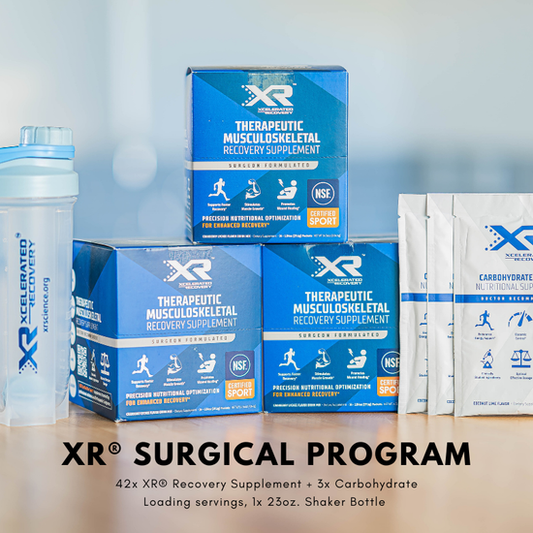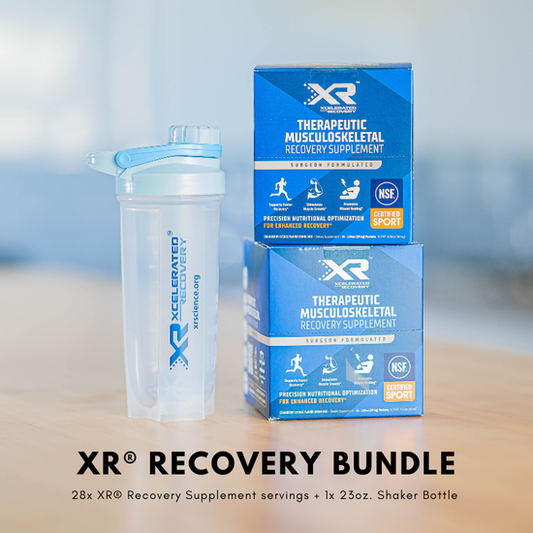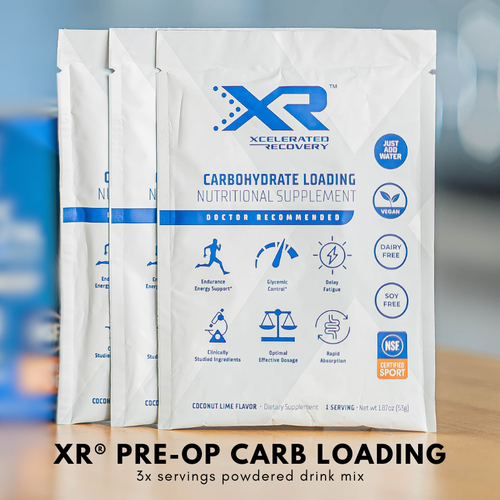
The Muscle-Centric Diet: Fueling for Optimal Recovery
Share
Authors: Dr. Reza Jazayeri & Dr. Kristofer Jones
Recovering from orthopedic surgery can be a challenging process, not only physically but also nutritionally. A common concern among both athletes and elderly undergoing orthopaedic surgery is the significant amount of muscle (atrophy) loss that is often difficult to recover from.
For example in athletes who sustain an ACL injury, it is not uncommon to see a 20-30% loss of muscle strength in the affected limb within the first few weeks after an ACL injury.
This muscle atrophy is further compounded by the stress of surgery. Though ACL reconstruction is effective in restoring anatomical stability of the knee, significant and prolonged deficits in quadriceps muscle size and strength are generally seen after surgery. This raises concerns for both athletes and surgeons regarding the timing and safety of returning to play, as well as the possibility of retears.
Muscle loss after surgery is not unique to athletes, and presents a common challenge particularly in patients undergoing joint replacements (knee/hip/shoulder). The most common reason for any joint replacement is for restoring function and decreasing pain secondary to osteoarthritis (OA). The average demographic of individuals who undergo joint replacements are older adults, typically over the age of 60, which is also the age in which both nutritional status and muscle mass tend to decrease. Most patients with chronic OA, have limited function and range of motion prior to surgery and therefore already present with decreased muscle mass prior to surgery.
Surgery triggers a cascade of inflammatory, immune, and metabolic responses that result in a hypermetabolic-catabolic state, as described by Hirsch et al. (2021). During this state, the body's demand for amino acids (AA) significantly increases. To meet this demand and aid in wound healing, the body breaks down skeletal muscle, which serves as the body's only reservoir for AA. However, this muscle breakdown results in muscle atrophy, which is made worse by the invasive nature of surgery and the limited activity and immobility required during the healing phase. This exacerbates the underlying muscle deficit and presents a significant obstacle in the recovery process.
It is essential for patients to work closely with their healthcare team to develop an individualized rehabilitation plan that focuses on maintaining and improving muscle strength. Prehabilitation, also known as prehab therapy, is a concept that has gained traction in recent years and refers to the process of preparing for surgery by engaging in physical and nutritional therapy prior to the procedure. This strategy is quickly becoming the standard for elective orthopedic surgeries. The goal of prehabilitation is to enhance a patient's physical condition and overall well-being prior to surgery, resulting in improved outcomes and a quicker recovery.
Nutritional status is a strong predictor of postoperative outcomes. Poor nutritional status is a common, often silent, condition impacting approximately 24% of young adults to 65% of elderly surgical patients. Poor nutritional status is linked to longer lengths of stay, higher readmission rates, a greater number of complications, slower return to sports and functional activity, as well as higher mortality risks.
Nutritional Strategies for Enhancing Surgical Outcomes:
The Nutrients journal article from 2021 titled "Pre- and post-surgical nutrition for preservation of muscle mass, strength, and functionality following orthopedic surgery" emphasizes the significance of adequate nutrition for patients before and after surgery. It has been shown that patients who optimize their protein intake during the perioperative period experience improved surgical outcomes and fewer complications. This can be achieved through what has been termed a “muscle-centric diet”.
What is a muscle-centric diet?
A muscle-centric diet is specifically designed to optimize muscle protein synthesis (MPS), the cellular process in which the body turns on the building process of muscle tissue by putting together amino acids. This nutritional approach focuses on obtaining adequate daily amino acid intake to address muscle loss during surgical recovery. Protein consumption, utilized as a nutritional tool, can help provide the appropriate amount of amino acids to optimally stimulate MPS.
Muscle protein synthesis (MPS) is triggered when a certain threshold of protein and amino acids is reached. In most healthy adults, this occurs after consuming 30 grams of high-quality protein. As we age, the body becomes more anabolically resistant, requiring higher doses of amino acids and protein to stimulate the same MPS. The recommended daily allowance (RDA) for protein of 0.8 g/kg does not take into account the amount of protein needed to support MPS and falls short of the required amount for optimal surgical recovery, particularly as we age. Patients recovering from major orthopedic surgery require a higher protein intake closer to 2.0 g/kg of body weight per day.
A muscle-centric diet is particularly valuable for patients recovering from orthopedic surgery, as it focuses on providing the body with the necessary nutrients to support muscle growth and recovery. A study Ryan et al. (2020) emphasizes the importance of higher protein consumption for recovery, stating that "protein is essential for the repair and growth of skeletal muscle tissue, and thus, higher protein intake is recommended during times of injury and recovery"
A muscle-centric diet should include an adequate intake of protein, carbohydrates, and healthy fats, as well as a variety of vitamins and minerals. Additionally, a muscle-centric diet may also include specific supplements such as creatine, HMB, and branched-chain amino acids (BCAAs) to further support muscle growth and recovery. The exact macronutrient ratio will depend on the individual's goals and activity level.
The XR recovery program takes into account all these important variables for promoting muscle recovery after orthopedic surgery, including macronutrient composition, timing, distribution, protein quality, and quantity. We understand that proper nutrition is crucial for healing and recovery, which is why we will determine all of these variables for you as part of the program. Additionally, a muscle-centric calculator will be utilized to provide customized diet recommendations and sample meal plans, ensuring that you receive the proper nutrition needed to promote healing and recovery.
To maximize muscle protein synthesis (MPS), it is recommended to trigger the process early in the morning, shortly after waking, by consuming 40-45 grams of high-quality protein within one hour of waking, as the body has been in a fasted state during sleep. Similarly, consuming approximately 45 grams of high-quality, slow-digesting proteins 2.5-3 hours before sleep is recommended to extend trigger MPS during sleep. Timing around exercise is also crucial. Consuming protein immediately before and after exercise has been proven to be more effective in promoting muscle growth and recovery than consuming it at other times during the day. Therefore, patients should consume a protein-rich meal or supplement before and after physical therapy or other forms of exercise.
In summary, a muscle-centric diet is a valuable nutritional approach for patients recovering from orthopedic surgery. It focuses on providing the body with the necessary nutrients to support muscle growth and recovery, which can help to optimize muscle protein synthesis and ultimately promote a faster and more successful recovery.
A muscle-centric diet should be individualized and tailored to the patient's specific needs. Xcelerated Recovery provides you with the muscle-centric calculator that customizes your individualized needs as well as dietary recommendations. This way, you can be assured that you are getting the right macronutrient ratio and protein, carbohydrate, and fat intake that you need to support a speedy recovery.
TRY THE MUSCLE CENTRIC CALCULATOR (click here)
References:
- Smith-Ryan AE, Hirsch KR. Nutritional Considerations and Strategies to Facilitate Injury Recovery and Rehabilitation. Curr Sports Med Rep. 2020;19(4):196-203.
- W. C. Schroer 2019 Chitranjan S. Ranawat Award: Elective joint arthroplasty outcomes improve in malnourished patients with nutritional intervention a prospective population analysis demonstrates a modifiable risk factor The Bone & Joint Journal 2019 Vol. 101-B, No. 7_Supple_C
- Hirsch, M., et al., 2021. The metabolic response to orthopedic surgery. Journal of Orthopaedic Research.








